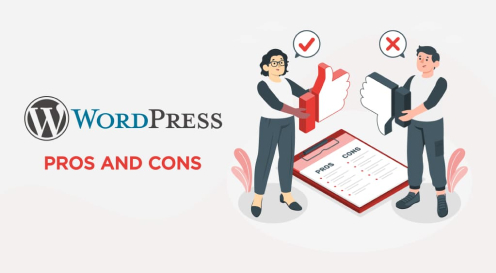The Essential Elements of eCommerce Web Design
14 Mar 2024 | 17 min read
There’s a lot more to running a successful eCommerce business than simply stocking great products!
The way that your eCommerce website looks and, more importantly, works is crucial to your success.
As the owner of an eCommerce store, you’ll want to do everything that you can to make sure that your site is as effective as possible.

So, what elements go into creating the most effective and efficient eCommerce store website possible? One that ensures a high visitor-to-customer conversion rate and keeps those customers coming back time and time again?
Read on to find out!
Introduction
In the dynamic world of online shopping, the design of an eCommerce website plays a pivotal role in defining the success of a business. It’s not just creating a visually appealing interface; it’s about crafting an experience that resonates with users, guiding them seamlessly from the first click to the final purchase.
The importance of eCommerce web design cannot be overstated. A well-structured website serves as the virtual storefront for your brand, creating the first impression that can either attract or repel potential customers. In an era where digital interaction is often the primary, if not the only, interaction customers have with a brand, your site’s aesthetic, functionality, and overall user experience become critical in building trust and encouraging sales.
Good web design is more than just a face for your business. It is the foundation upon which user experience is built. A site that’s easy to navigate, loads quickly, and is optimized for mobile devices directly impacts customer satisfaction. It’s about understanding and anticipating the needs of your visitors, providing them with a hassle-free shopping journey. When customers enjoy the time they spend on your website, they are more likely to return, recommend it to others, and, most importantly, make a purchase.
In essence, eCommerce web design is not just about creating a site that looks good; it’s about designing a journey that feels good. A journey that’s intuitive, engaging, and rewarding. This harmony of form and function drives sales, fosters brand loyalty, and sets the foundation for long-term business success in the bustling online marketplace.
User-Friendly Design
A user-friendly design is the cornerstone of customer engagement and retention in eCommerce. It’s all about creating an environment where customers can easily navigate effortlessly, find what they’re looking for, and enjoy their shopping experience.
The Importance of a User-Friendly Interface
The interface of your eCommerce website is like the layout of a physical store. Just as shoppers prefer well-organized, navigable, and comfortable physical stores, online shoppers seek a similar experience in digital spaces. A user-friendly interface minimizes confusion, helps visitors find products quickly, and simplifies purchasing. When users encounter a cluttered or complex website, it’s akin to walking into a disorganized store; they’re likely to leave without purchasing.
Ensuring Cross-Device Compatibility and Ease of Use
In today’s world, where people access the internet from various devices, ensuring cross-device compatibility is crucial. Your website should deliver a consistent and efficient experience, whether accessed from a desktop, a tablet, or a smartphone. This means optimizing layout, text, images, and functionalities to adapt seamlessly to screen sizes and resolutions. Making your website responsive ensures that a mobile phone customer enjoys the same quality experience as someone on a desktop.
Highlighting the Significance of Mobile Responsiveness
In today’s digital era, mobile responsiveness is not just a feature; it’s a fundamental component of successful eCommerce web design. With an ever-increasing number of consumers using smartphones and tablets for online shopping, the importance of mobile-friendly websites cannot be overstated. Here’s why mobile responsiveness is so crucial:
- Expanding Mobile User Base: A significant and growing proportion of online traffic comes from mobile devices. Customers are increasingly likely to browse, research, and make purchases on their smartphones. Therefore, a website optimized for mobile use is essential to cater to this substantial user base.
- Enhanced User Experience: Mobile responsiveness ensures that your website’s layout, images, text, and functionalities are automatically adjusted to fit every screen of mobile devices. This optimization provides a smoother, more intuitive experience for mobile users, making it easier to browse products, read descriptions, and complete purchases without unnecessary zooming or scrolling.
- Improved Search Engine Rankings: Search engines like Google prioritize mobile-friendly websites in their search results. This means that having a mobile-responsive website can enhance your SEO efforts, making your site more visible and easily discoverable to potential customers searching online.
- Reduced Bounce Rates: When a website is not optimized for mobile, it often leads to a frustrating experience for users, who may quickly leave or ‘bounce’ from the site. A mobile-responsive design keeps users engaged and interested, decreasing bounce rates and increasing conversion possibilities.
- Competitive Advantage: Offering a mobile-responsive website can set your eCommerce business apart from competitors who may have yet to adapt to this necessity. It shows that you value your customers’ experience and are committed to providing them easy access to your services and products, regardless of their device.
Easy Navigation
Navigating an eCommerce website should be like walking through a well-organized store: straightforward, intuitive, and hassle-free. The ease with which customers can find what they’re looking for directly influences their shopping experience and, ultimately, their decision to purchase. Let’s delve into the strategies for creating an intuitive navigation system and the importance of clear menus and categories.
Strategies for Creating an Intuitive Navigation System
Creating an intuitive navigation system is all about simplicity and predictability. Here are some key strategies:
- Logical Structure: Organize your website in a way that makes sense. Group similar items together and use familiar terms in your navigation labels. For instance, if you’re selling clothing, categorize items as ‘Men,’ ‘Women,’ ‘Kids,’ etc.
- Search Functionality: Implement a robust search feature. Sometimes, customers know exactly what they want, and a search bar helps them find it quickly.
- Breadcrumbs: Use breadcrumb navigation to help users keep track of their locations within your website. It’s like leaving a trail back to the homepage.
- Limit Menu Items: Avoid cluttering your navigation menu with too many items. Stick to essential categories and use subcategory dropdown menus to keep things organized.
- Responsive Design: Ensure your navigation is easy to use on all devices. Menus that work well on a desktop might need adjustments to be user-friendly on mobile devices.
Importance of Easy-to-Read Menus and Clear Categories
Menus are the roadmap of your eCommerce site. They guide customers through your store, so they must be clear and easy to navigate:
- Clarity: Use clear, descriptive labels for your menu items. Avoid vague or technical jargon that might confuse shoppers.
- Visibility: Menus should be prominently placed where visitors expect them – across the top or along the left side of the page.
- Consistency: Keep the style and location of your navigation consistent across all pages. Changing the layout or style can disorient users and create a frustrating experience.
- Hierarchy: Establish a clear hierarchy in your menu structure. Main categories should be immediately visible, with subcategories logically arranged beneath them.
High-Quality Product Images and Videos
In the digital marketplace, where touch and feel are impossible, high-quality product images and videos become the sensory bridge between your products and customers. They are crucial in conveying the quality and details of your products, enhancing their appeal, and ultimately influencing purchasing decisions.

The Role of High-Quality Images in Enhancing Product Appeal
High-quality images serve as the visual handshake between your product and potential buyers. They play several vital roles:
- Building Trust: Clear, detailed images demonstrate the quality of your product, building faith with your customers. They see what they’re getting, reducing doubts and hesitations.
- Boosting Engagement: Beautiful, high-resolution images capture attention. In a sea of products, those with striking visuals stand out and engage users more effectively.
- Enhancing Understanding: Good images can communicate features and benefits faster than text. They provide a quick understanding of what the product is about.
Tips for Using Product Images to Provide a Realistic Representation
Here are some practical tips to maximize the impact of your product images:
- Multiple Angles: Show your product from various angles. This gives customers a comprehensive view, simulating the experience of examining a product in person.
- Zoom Functionality: Allow users to zoom in for finer details. This feature can highlight the quality of materials, texture, and craftsmanship.
- Consistent Lighting and Background: Use consistent lighting and backgrounds for your product images. This uniformity helps customers focus on the product without distractions.
- Contextual Shots: Include images of your product in use or its intended environment. If you’re selling a coffee mug, show it filled with coffee on a breakfast table.
- 360-Degree Views and Videos: Where possible, provide 360-degree views and short videos demonstrating the product in action. This gives an even clearer idea of what to expect.
Compelling Product Descriptions
Product descriptions are crucial in online shopping in guiding the customer’s buying decision. Unlike a physical store, where the product can speak for itself, your product description does the talking in an online store. Let’s explore how to craft effective descriptions that inform, entice, and persuade your customers to purchase.

Crafting Effective Product Descriptions that Drive Sales
Effective product descriptions do more than describe; they sell. They should:
- Highlight Key Features: Start with the most important features of your product. What makes it unique? Why would someone need it? Be particular about what sets your product apart.
- Focus on Benefits: While features are about the product, benefits are about the customer. How will the product improve their life or solve a problem they have? For instance, if you’re selling a backpack, highlight its ergonomic design that ensures comfort during long travels.
- Use the Right Tone: The tone of your descriptions should match your brand voice and appeal to your target audience. If your brand is playful and fun, let that shine through in your writing.
- Be SEO Friendly: Incorporate keywords naturally to improve search engine rankings, but avoid keyword stuffing. Remember, you’re writing for humans first, search engines second.
Techniques to Make Descriptions Concise, Clear, and Engaging
To keep your product descriptions concise and engaging:
- Use Bullet Points: Bullet points make the text easier to scan and digest. List the most critical features or benefits in a bullet format.
- Avoid Jargon: Use simple language that your average customer will understand. Steer clear of industry-specific terms unless your product is aimed at a specialist market.
- Tell a Story: Write a short story about your product if appropriate. This can create an emotional link with the customer.
- Include Social Proof: Where relevant, include customer testimonials or ratings within your product description. This adds credibility and can be a powerful persuader.
- Edit Ruthlessly: After writing your description, go back and cut out any unnecessary words or phrases. Keep it as brief as possible while still being informative and engaging.
Search Engine Optimization (SEO)
In the digital marketplace, where visibility is key to success, Search Engine Optimization (SEO) plays a crucial role. SEO is not just an add-on but an integral part of eCommerce web design, deeply influencing how easily potential customers can find your online store.

The Necessity of Incorporating SEO in eCommerce Web Design
Integrating SEO into your eCommerce site’s design is essential for various reasons:
- Increased Visibility: Appearing higher in search engine results pages (SERPs) increases the likelihood of possible customers finding your website when they search for products you offer.
- User Experience: Good SEO practices align with creating a user-friendly website. This includes fast loading times, mobile responsiveness, and clear navigation, all contributing to a positive user experience.
- Cost-Effective Marketing: While paid advertising can drive traffic to your site, SEO provides a more cost-effective and sustainable approach. Organic search traffic, driven by good SEO, is often a significant source of visitors to your site.
How SEO Practices Impact Visibility and Traffic
Effective SEO strategies have a profound impact on the visibility and traffic of your eCommerce site:
- Keyword Optimization: Using the proper keywords in your product titles, descriptions, and content helps your site show up in relevant searches. This means more customers can discover your products.
- Quality Content: Creating informative, valuable content around your products or industry can attract more visitors to your site. This includes blog posts, buying guides, and product reviews.
- Site Structure and Navigation: A website with a clear navigation structure aids search engines in effectively crawling the site, improving its visibility.
- Mobile Optimization: As search engines prioritize mobile-friendly sites, ensuring your eCommerce site is optimized for mobile users can significantly boost your search rankings.
- Backlink Building: Obtaining backlinks from high-quality websites improves your site’s authority and directs more traffic to your site.
Streamlined Checkout Process
Checkout is a critical moment in the customer’s journey in the eCommerce landscape – the final hurdle before a sale is secured. A smooth checkout process is essential for enhancing user experience and reducing cart abandonment, a common challenge for online retailers.
Importance of a Simple and Quick Checkout Process to Reduce Cart Abandonment
A complicated or time-consuming checkout process can be a major deterrent for customers, leading them to abandon their carts. Here’s why simplicity and speed are key:
- Reduced Friction: A straightforward checkout minimizes confusion and potential frustration, reducing the chances that customers will give up before completing their purchase.
- Enhanced Customer Experience: A quick and easy process respects the customer’s time and leaves a positive, lasting impression, increasing the likelihood of return visits and repeat purchases.
- Improved Conversion Rates: Simplifying the checkout process can directly impact your bottom line by increasing the conversion rate of visitors into paying customers.
Features that Make the Checkout Process More User-Friendly
To make your checkout process more user-friendly, consider implementing these features:
- Guest Checkout Option: Enable customers to make purchases without creating an account. This can speed up the process and is particularly appealing to first-time customers.
- Clear Progress Indicators: Show customers where they are in the checkout process, such as ‘Shipping Details,’ ‘Payment Information,’ and ‘Confirmation.’ This transparency helps manage expectations and reduces anxiety about the length of the process.
- Multiple Payment Options: Offering different payment methods, including credit cards, PayPal, and digital wallets, caters to different preferences and can streamline the payment process.
- Auto-Fill Functionality: Implement auto-fill for returning customers to expedite the process. This feature can automatically input known information, saving time and effort for the customer.
- Error Handling and Guidance: Clearly indicate when a mistake is made during input (such as an invalid card number) and provide immediate guidance on correcting it.
- Order Summary and Confirmation: Display an order summary for final review before submission and send a confirmation message or email once the purchase is complete. This reassures customers that their transaction was successful.
Consistent Branding
Establishing a unique identity is crucial in the digital world, where countless brands vie for attention. Consistent branding across your eCommerce website and other digital platforms is key to building brand recognition and trust. Let’s explore how consistent branding can be effectively implemented.
Ensuring the Website Reflects the Brand’s Identity and Values
Clarified the importance of accurately reflecting brand identity and values.:
- Visual Elements: Ensure that your logo, color scheme, typography, and other visual elements on your website align with your brand’s style guide. This visual consistency helps reinforce brand recognition.
- Brand Voice and Messaging: The tone and language used throughout your website should mirror your brand’s personality. Whether professional, friendly, quirky, or serious, maintaining a consistent voice helps forge a connection with your audience.
- Values and Storytelling: Your brand’s values should be evident in the content of your website. Share your brand story, mission, and the principles that guide your business. This can resonate deeply with customers who share similar values.
- Imagery and Content: Use images and content that align with your brand’s ethos. For instance, if your brand is committed to sustainability, use imagery and content highlighting this commitment.
Using Consistent Branding Across All Digital Platforms
Consistency across all digital platforms extends your brand’s reach and reinforces its identity:
- Social Media Presence: Ensure your brand’s aesthetic and voice are consistent across all social media platforms. This includes using the same profile pictures, cover photos, and similar post styles.
- Email Marketing: Emails sent to customers should reflect the same branding as your website, whether for marketing or transactional purposes. This includes using similar templates, colors, and language.
- Digital Advertising: Ads placed on various platforms should be instantly recognizable as belonging to your brand. Consistency in design and messaging helps in maintaining a cohesive brand experience.
- Online Customer Service: Customer service interactions should reflect your brand’s voice. Whether through chatbots, emails, or social media responses, how you communicate should align with your brand’s personality.
Clear Call to Action (CTA)
In the digital marketplace, a clear Call to Action (CTA) is more than just a button or a line of text; it’s a crucial guidepost that leads customers through the buying process. A well-crafted CTA can significantly boost user engagement and conversion rates, playing a pivotal role in the success of your eCommerce strategy.
Designing Effective CTAs to Guide Users Through the Buying Process
Effective CTAs are the signposts that guide users on what to do next. Here’s how to design them effectively:
- Visibility and Design: Your CTA should stand out visually. Use colors that contrast with the rest of your page to make it noticeable. The size and shape of the button should also draw attention without being overwhelming.
- Strategic Placement: Place CTAs where users are most likely to take action, such as near product descriptions, at the end of blog posts, or within email content. The placement should feel natural to the flow of the user’s journey.
- Clear Language: Use action-oriented, concise language. Phrases like ‘Buy Now,’ ‘Sign Up,’ ‘Learn More,’ or ‘Get Started’ clearly communicate what action you want the user to take.
- Urgency and Incentive: Create a sense of urgency or offer an incentive. Phrases like ‘Limited Offer’ or ‘Sign up today and get a 10% discount’ can encourage users to take action immediately.
- Testing and Optimization: Continuously test different kinds of your CTAs to see which ones perform the best. This could be changing the wording, color, or placement to optimize their effectiveness.
The Impact of CTAs on Conversion Rates
CTAs are a key element in converting website visitors into paying customers:
- Directing Customers: A clear CTA directs customers on what to do next, removing any ambiguity that might prevent them from taking action.
- Enhancing User Experience: Well-placed and well-designed CTAs contribute to a seamless user experience, making it easier for customers to navigate and complete their desired actions.
- Boosting Engagement: An effective CTA can entice users to engage more with your content, whether signing up for newsletters, downloading a guide, or purchasing.
- Measuring Effectiveness: CTAs provide measurable data. Analyzing how users interact with your CTAs lets you get valuable insights into user behavior and preferences, helping you refine your marketing strategies.
Security Features
In the digital era, where data breaches are increasingly common, implementing robust security measures in eCommerce is not just a feature – it’s a necessity. Strong security practices protect customer data and build trust and credibility for your brand.
Implementing Robust Security Measures to Protect Customer Data
Protecting customer data should be a top priority for any eCommerce business. Here are key security measures to implement:
- Data Encryption: Use encryption to protect sensitive customer data, such as credit card information and personal details. This ensures that even if data is intercepted, it remains unreadable and secure.
- Secure Sockets Layer (SSL) Certificates: SSL certificates are essential for securing online transactions. They encrypt the data transferred between the user’s browser and your website, ensuring that sensitive information is protected.
- Regular Security Audits: Conduct regular security audits to identify and address vulnerabilities. This involves checking for software updates and potential system weaknesses and ensuring that all security measures are current.
- Compliance with Standards: Ensure your website complies with relevant standards and regulations, such as the Payment Card Industry Data Security Standard (PCI DSS). Compliance not only improves security but also enhances customer confidence.
- User Education: Educate customers about safe online practices, such as creating strong passwords. Providing tips and information can help them protect their accounts on your site.
SSL Certificates, Multi-Factor Authentication, and Regular Security Updates
Delving deeper into some key security features:
- SSL Certificates: An SSL certificate is a must for any eCommerce site. It encrypts data sent over the internet, ensuring that customer information remains private and secure.
- Multi-Factor Authentication (MFA): MFA adds an extra layer of security by requiring users to provide two or more verification factors to access an account, making it harder for unauthorized users to breach customer accounts.
- Regular Security Updates: Keeping your software and platforms updated is crucial. Regular updates often include security patches that protect against new vulnerabilities.
Multiple Payment Options
Offering multiple payment options is not just a matter of convenience; it’s about catering to the diverse preferences of your customers, enhancing their shopping experience, and potentially increasing your conversion rates.
- Wide Range of Options: Provide various payment methods, including credit cards, debit cards, digital wallets like PayPal, and even newer options like cryptocurrency if they align with your customer base.
- Payment Gateway Security: Ensure that your payment gateways are secure and reliable. Look for gateways that offer additional security measures like tokenization, which replaces sensitive data with unique identification symbols.
- Easy Checkout Process: The payment process should be seamless and user-friendly. A complicated or lengthy payment process can lead to cart abandonment.
- Localization: Consider offering local payment options for different regions. Localized payment solutions can significantly improve the shopping experience for international customers.
Navigating the intricate landscape of eCommerce can be challenging. Still, with the right strategies and tools, it becomes a journey of growth and success. From ensuring a user-friendly design that resonates across various devices to crafting compelling product descriptions, each element plays a vital role in sculpting a memorable online shopping experience. The significance of SEO in enhancing your visibility, the importance of a streamlined checkout process, and the implementation of robust security measures cannot be understated. They collectively forge a path that not only leads to customer satisfaction but also to business prosperity.
Chetaru is your ideal partner for eCommerce web design. With our expertise and experience, we can help you create an online store that’s visually appealing, functionally robust, secure, and optimized for success. Whether starting a new venture or looking to enhance your existing online presence, Chetaru guides you through every step. Let’s embark on this journey together and unlock the true potential of your eCommerce business. Contact Chetaru today to begin your journey towards eCommerce excellence.
See What Chetaru Could Do for Your eCommerce Business
We eat, drink and dream digital marketing at Chetaru – and building fantastic eCommerce websites that attract traffic and leads is one of specialities.
Ping an email to info@chetaru.com if you’d like to find out more about how Chetaru’s web design service could optimise your eCommerce store and help you increase sales.


